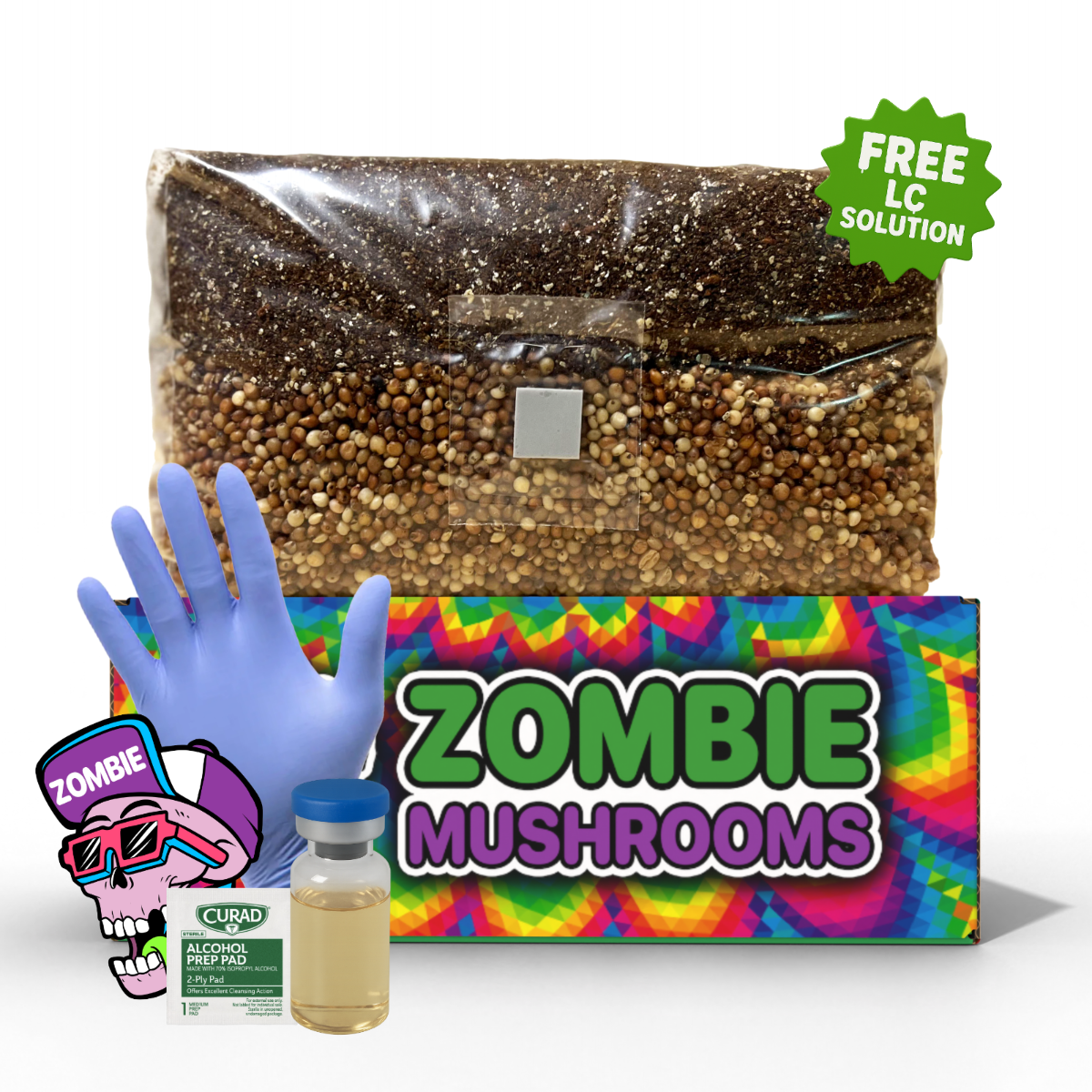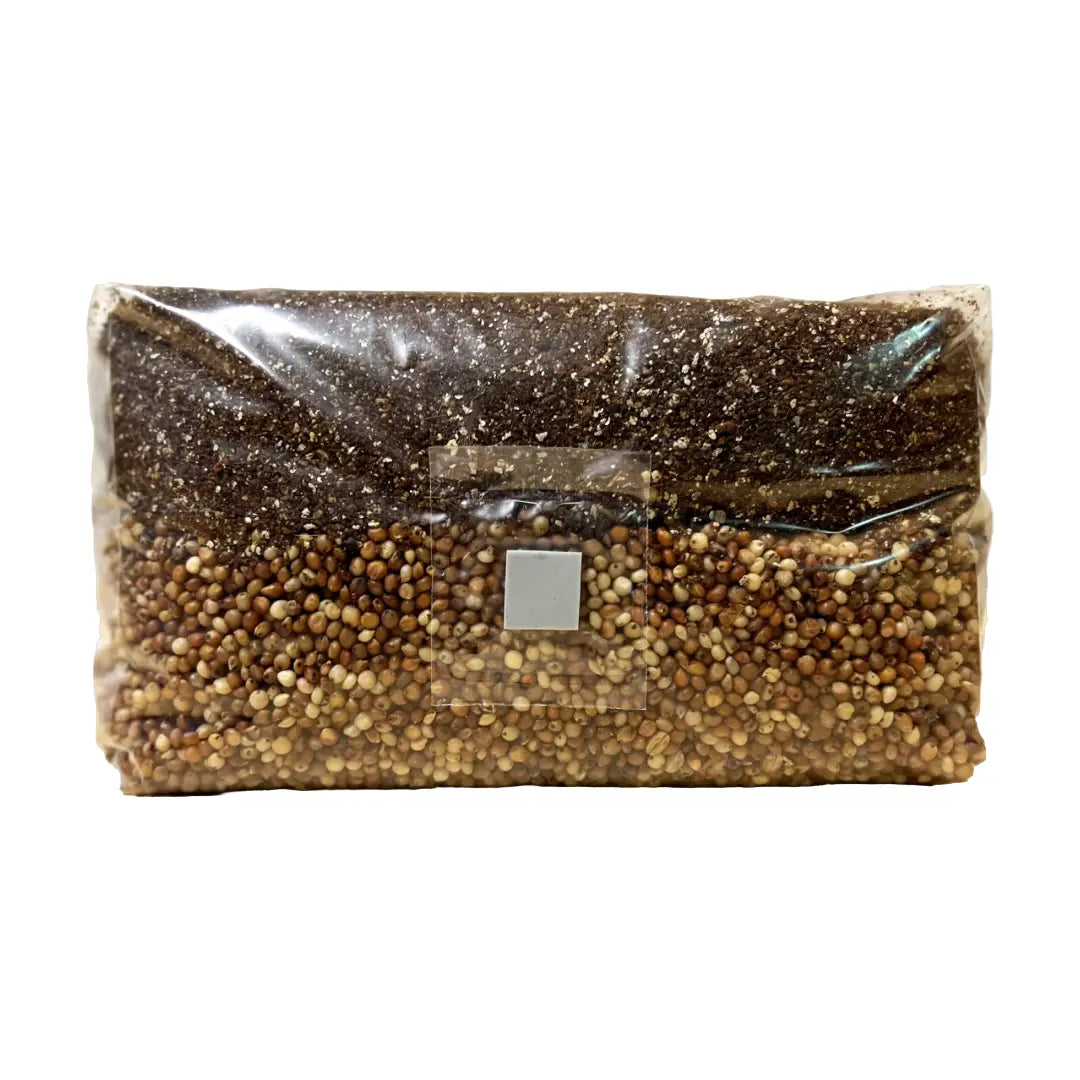1. Introduction to the Shotgun Fruiting Chamber (SGFC)
If you’re growing mushrooms at home and want an affordable, low-maintenance setup that still delivers good results, the Shotgun Fruiting Chamber (SGFC) is a solid choice. It gives you control over critical factors like humidity, airflow, and indirect light—without complex gear.
For many growers, pairing an SGFC with mushroom grow bags or monotub kits helps reduce mess and improve consistency. In this guide, we’ll walk you through how to build, use, and maintain your SGFC, when to use it vs a monotub, and how to troubleshoot common issues so your flush yields are healthy and reliable.
The name "shotgun fruiting chamber" comes from the design—users drill many evenly spaced holes in the chamber's container, somewhat resembling the spread pattern of buckshot from a shotgun blast. These holes allow for passive airflow while maintaining humidity, making the SGFC a reliable and low-maintenance choice for both mushroom cultivation beginners and experienced growers.
2. Why Use the Shotgun Fruiting Chamber Method?
There are several reasons why the SGFC method stands out as an ideal option for growing mushrooms, especially for backyard growers or those cultivating small-scale crops indoors.
High Humidity Levels
Mushrooms are more than 90% water and need a high-humidity environment (usually between 85% and 95%) for fruiting. The perlite lining the bottom of the SGFC retains moisture, which helps create the humid conditions required for most species. By gradually releasing water into the surrounding air, the perlite maintains this high humidity over a prolonged period. Depending on your environment, you may only need to re-soak the perlite every couple of weeks or periodically mist your chamber to keep the humidity at an optimal level.
Fresh Air Exchange (FAE)
Good airflow is crucial in mushroom cultivation. Mushrooms release carbon dioxide (CO2) as they grow, and the build-up of CO2 can inhibit growth, leading to thin, malformed mushrooms. The strategic placement of regularly spaced holes around the SGFC facilitates continuous airflow, promoting oxygen-rich conditions while ensuring proper evaporation and preventing CO2 build-up.
Affordable & Simple Construction
For those just starting their mushroom-growing journey, investing in advanced cultivation gear can get expensive. The beauty of the SGFC lies in its affordability and simplicity. You don't need an expensive humidifier, CO2 monitors, or complex air exchange systems. With just a clear plastic bin, perlite, and a drill, you’ll have everything you need to get started.
Adaptable for Multiple Species
A robust feature of the SGFC is its adaptability to different mushroom types. Gourmet species like oysters, shiitakes, maitake, and even the tricky lion’s mane can fruit successfully within an SGFC. However, it is particularly well-suited for species that rely on humidity levels exceeding 85%, such as psilocybin mushrooms—making this chamber design the beginner grower’s best friend across various mushroom species.
Minimal Ongoing Maintenance
Aside from occasionally misting the inside and rehydrating the perlite, an SGFC requires minimal maintenance. Unlike more complicated methods like monotub setups requiring ongoing interventions, an SGFC is largely "set it and forget it," offering the simplicity most people want in a DIY mushroom project.
Step-by-Step Guide to Building Your SGFC
Constructing an SGFC at home is cost-effective and doesn’t require specialized skills. Follow this step-by-step guide to ensure your mushrooms fruit to their fullest potential.
3. What You’ll Need
Before you start building your SGFC, you'll need to gather a few essential supplies. Fortunately, all of these can be found at your local home improvement or gardening store, or you can order them online.
-
Plastic Bin: Opt for a clear or semi-clear plastic storage tub, ideally with dimensions around 18" x 12" x 12" for smaller setups (adjust depending on the amount of substrate or number of kits you want to accommodate). The transparency of the plastic will allow for indirect light to filter into the chamber.
Tip: Consider a bin with tight-sealing edges to help control humidity better.
-
Perlite: A natural, volcanic material known for its outstanding moisture-retaining properties. You'll need enough perlite to create a 3-4 inch thick layer at the base of the bin. This equates to about 2 to 3 gallons of perlite, depending on the size of your chamber.
-
Drill with a 1/4-Inch Drill Bit: For making evenly spaced holes to ensure proper airflow. The quarter-inch size is ideal for promoting fresh air exchange without drying out the chamber too quickly.
-
Water Mister: Essential for maintaining a high level of humidity inside the chamber. Spray the chamber to refresh humidity as needed.
-
Protective Gear: It’s always advisable to use gloves and a dust mask when handling dry perlite to prevent inhalation of fine particulate matter.
4. Step 1: Mark Out Holes on the Chamber
Use a ruler or template to evenly mark hole placement. Aim for about 2-inch spacing on all six sides: front, back, sides, top, and bottom. This ensures consistent Fresh Air Exchange (FAE) to prevent CO₂ pockets.
Why Spacing Matters
The spacing of the holes is critical to creating the proper FAE dynamic. A well-ventilated chamber doesn’t deprive mushrooms of oxygen, which they need during fruiting stages. Additionally, poor airflow can result in high CO2 levels near the bottom of your chamber, limiting the fruiting body's size and health.
Bonus Tip: If you find yourself continually adjusting airflow by adding or blocking holes after your mushrooms start fruiting, it means airflow dynamics need fine-tuning. Each room's air pressure and circulation are different, so some trial and error may be necessary.
5. Step 2: Drill the Holes
Now that you’ve marked your bin, use your drill to make ¼-inch holes across all sides. This will allow air to move freely throughout the chamber but still trap moisture inside. Ensure that you’re evenly spacing your holes about 2 inches apart, including on the bottom of the bin.
Drill All Sides: Why Top and Bottom Holes Matter
Don’t skip placing holes on the top and bottom of the fruiting chamber. Air currents are an integral part of moving moisture and CO2. The top-hole vents allow water vapor to escape slowly, creating the necessary evaporation and condensation cycle that promotes mushroom growth. The bottom holes prevent standing moisture from accumulating.
6. Step 3: Fill the Bottom of the Chamber with Perlite
Once your holes are drilled, line the bottom of the SGFC with 3 to 4 inches of soaked perlite. If you're new to perlite, here's a quick crash course.
What is Perlite?
Perlite is a form of expanded volcanic glass that has been processed to make it lightweight and porous, allowing for excellent water retention. In mushroom-growing setups, perlite serves to maintain the high humidity levels needed for successful fruiting.
Once you've placed the perlite in your chamber, you'll need to soak it. Pour enough water over the perlite and stir it around to ensure even absorption. Then, drain any excess water—perlite should be moist but not soggy.
Why Perlite?
Perlite doesn’t just hold water; it also ensures that the humidity remains consistent over time. Unlike using a traditional humidifier or evaporative pad, perlite requires no electric parts or additional upkeep. Its porous surface allows it to slowly release moisture into the chamber.
7. Step 4: Soaking the Perlite to Maximize Humidity
Soaking perlite properly is one of the most crucial steps in creating a consistent microclimate inside your SGFC. Before placing it in the chamber, the perlite should sit in a bucket of clean water to thoroughly saturate it.
How to Soak Perlite Correctly
-
Thoroughly rinse the perlite under running water in a large bucket.
-
Soak it in water for about 30 minutes to ensure it absorbs enough moisture.
-
Once soaked, drain the water thoroughly. The goal is for the perlite to be wet, not sitting in residual water. You can tell the perlite is perfectly soaked if, when squeezed, very little or no water drips out.
Pro Tip: Make sure you avoid allowing pools of standing water inside the SGFC. Standing water can lead to bacterial buildup and mold growth, which can damage or destroy your crops.
8. Step 5: Place Your Mushroom Block in the Chamber
Now that your SGFC is prepared, it's time to add your mushroom substrate or mushroom-growing kit.
How to Position Your Substrate
Ensure that the mushroom block or kit is elevated inside the chamber using a small rack or tray. You can use synthetic or metal racks found in kitchen stores or craft your own supports. Ensure that the block doesn’t come in direct contact with the damp perlite below to prevent oversaturation.
Elevating the substrate also ensures adequate airflow around the block, especially at the bottom where CO2 tends to settle. This elevation enables small amounts of passive air movement underneath the block, helping to fight against stagnation and improving fruiting conditions.
Light Requirements
Mushrooms don’t perform photosynthesis, but they still require indirect, natural light to grow properly. In most species, exposure to light triggers the fruiting process. However, too much direct sunlight can dry out your chamber and even harm the mushrooms. Place your SGFC in an area that allows 12-14 hours of indirect sunlight exposure daily, or consider using a regular daylight spectrum LED.
9. Lighting for Your SGFC
While mushrooms don’t need intense light, they do use indirect light as a signal to begin forming fruiting bodies. You don’t need fancy grow lights; positioning the SGFC near a window where it can receive indirect sunlight will work fine. If your home has poor natural light, or your grow room lacks windows, consider supplementing with an artificial light that mimics natural daylight.
Light Placement
Mushrooms typically benefit from about 12-16 hours of light per day. LED grow lights with good daylight spectrum mimic outdoor light conditions well and can work for your setup. Place the lights at a distance where they don’t provide heat—mushrooms are extremely susceptible to drying out and overheating from excessive direct light and heat.
10. How to Maintain Your SGFC
Proper SGFC maintenance is a blend of misting, fanning, and keeping an eye on your substrate. Even small neglects could lead to reduced mushroom yields or delays in fruiting. Here’s a breakdown of the most important routine tasks:
Humidity Control
Humidity levels between 85% and 95% are ideal for growing a wide range of mushroom species. To maintain these levels:
-
Mist the perlite, walls, or lid daily. Your substrate should never be directly misted, as that can promote bacteria and mold.
-
Check humidity levels often with a hygrometer (available in most gardening or mycology supply stores to ensure your levels are in the desired range). If levels drop below 80%, you may need to add more mist or rehydrate the perlite.
Airflow and CO2 Management
Fresh air exchange is another critical aspect of maintaining your SGFC. Mushrooms thrive in oxygen-rich environments with lower CO2 levels:
-
Fan the SGFC: Using the lid of your SGFC, fan fresh air into the bin 2-3 times a day. This helps expel trapped CO2 and refreshes the environment inside the chamber.
Alternatively, you can set up your SGFC near an open window or in a room with steady airflow to help maintain better oxygen saturation levels. However, avoid drafts of very cold air as this could shock the mushrooms.
General Care
Maintaining your SGFC is minimal, but make sure you’re keeping an eye on the perlite and cleanliness inside the chamber. You don't want any foreign substances to contaminate the substrate or affect the environmental balance.
11. Troubleshooting Common Issues with Your SGFC
Despite its straightforward design, things can occasionally go wrong with an SGFC setup. Here are some solutions to common problems you might encounter:
Issue: Low Humidity
Symptoms: Mushrooms are cracked, drying out before maturation.
-
Solution: Increase the frequency of misting or re-soak the perlite. Adding a humidity tent with an additional plastic bag over the chamber can help trap more moisture.
Issue: Mushroom Stems are Long and Thin (Leggy Mushrooms)
Symptoms: Mushrooms have elongated stems and small caps.
-
Solution: This is often a sign of high CO2 buildup. Increase ventilation by fanning more frequently or adding more holes to your SGFC.
Issue: Presence of Contamination
Symptoms: Strange smells, discoloration, or mold growing on the substrate.
-
Solution: Isolate and remove any clearly contaminated substrates. If contamination persists, use sterile methods when filling and covering the SGFC to prevent future contamination and regularly clean the chamber.
12. Additional Tips for Maximizing Mushroom Yield
If you want to take your mushroom-growing experience to the next level, here are some pro tips to ensure the best results from your SGFC:
Sterility is Essential
When handling any mushroom substrate, always clean your hands or wear gloves. Contaminants can easily infiltrate the substrate—bacteria, molds, or other unwanted fungi can derail a potentially fruitful crop within days.
Experimentation is Key
Encourage yourself to explore growing different mushroom species side-by-side to see how they perform under varying environmental conditions. Certain types of mushrooms, like enoki or shiitake, may thrive under slightly cooler or warmer temperatures compared to an oyster or pearl mushroom.
Be Patient
Growing mushrooms requires patience, especially during the fruiting phase. The first flush (initial crop) could take several weeks to develop, but subsequent flushes may come faster.
Laying Perlite in Layers
Layer your perlite in smaller increments and mist between each layer. This ensures more even moisture retention throughout the bin.
13. Conclusion: Building a Shotgun Fruiting Chamber
Whether you're a first-time grower or someone looking to improve your mushroom yield, a Shotgun Fruiting Chamber is one of the most accessible and effective methods available. Its simple construction and minimal maintenance allow mushroom growers to replicate nature’s balance between humidity and fresh air flow right in their homes. By following the steps in this guide, you’ll be on your way to a plentiful mushroom yield with minimal effort.
An SGFC is more than just a passive container—it is a dynamic, adaptable environment that will help you tailor the perfect growing conditions for nearly any species of mushrooms. Just remember, attention to detail when it comes to moisture, air exchange, and light will determine the difference between a good yield and an incredible one!
14. FAQ
-
What’s the difference between an SGFC and a monotub?
SGFCs are easier to build, generally more compact and lower cost. Monotubs often offer larger space, better flush capacity, and sometimes lower maintenance once established—but require more substrate and more careful control. -
How big should my SGFC be?
A common size is around 18″ × 12″ × 12″, but you can scale up or down depending on how many mushroom blocks or grow bags you plan to fruit. Just keep hole spacing and humidity consistent. -
Do I need fancy equipment like humidifiers or CO₂ meters for an SGFC?
Not necessarily. Perlite + regular misting typically handle humidity. Fan-ing or opening the lid provides airflow. CO₂ meters are helpful but optional for small setups. -
How often should I mist or rehydrate perlite in an SGFC?
Aim to mist or soak perlite when humidity drops—often every few days to once a week, depending on your environment—so humidity stays in the 85-95% range. -
What are common problems in SGFCs and how do I fix them?
-
Low humidity: increase misting or re-soak perlite directly.
-
Leggy mushrooms (long stems, small caps): improve airflow via additional holes or more frequent fanning.
-
Contamination or mold: remove affected substrate immediately, ensure clean tools, and maintain cleanliness of the chamber interior.
-
15. Key Takeaways
-
Cost-Effective Setup: The Shotgun Fruiting Chamber is affordable and easy to build, requiring only basic materials like a plastic bin, perlite, and a drill.
-
Humidity & Perlite: High humidity is key to fruiting mushrooms successfully, and perlite plays a crucial role in maintaining proper moisture levels.
-
Fresh Air Exchange (FAE): The design of the SGFC allows fresh air circulation that prevents CO2 build-up—a detrimental condition to mushroom growth.
-
Ideal for Beginners and Versatile for Different Species: An SGFC is adaptable for growing a wide range of species, from oysters to lion’s mane mushrooms.
-
Minimal Maintenance: With just regular misting to maintain moisture and occasional fanning to ensure good airflow, the SGFC offers a low-maintenance solution for mushroom cultivation.
-
Lighting: Ensure access to indirect light or use artificial daylight spectrum bulbs to simulate natural lighting conditions required for fruiting.
16. Call to Action
Feeling inspired to start your own mushroom-growing journey? Visit our store to get the supplies you need, including high-quality perlite, mushroom-growing kits, and precise humidity gauges designed for growers like you. Sign up for our newsletter to keep updated with the latest tips, tutorials, and products for all your mushroom-growing needs.














